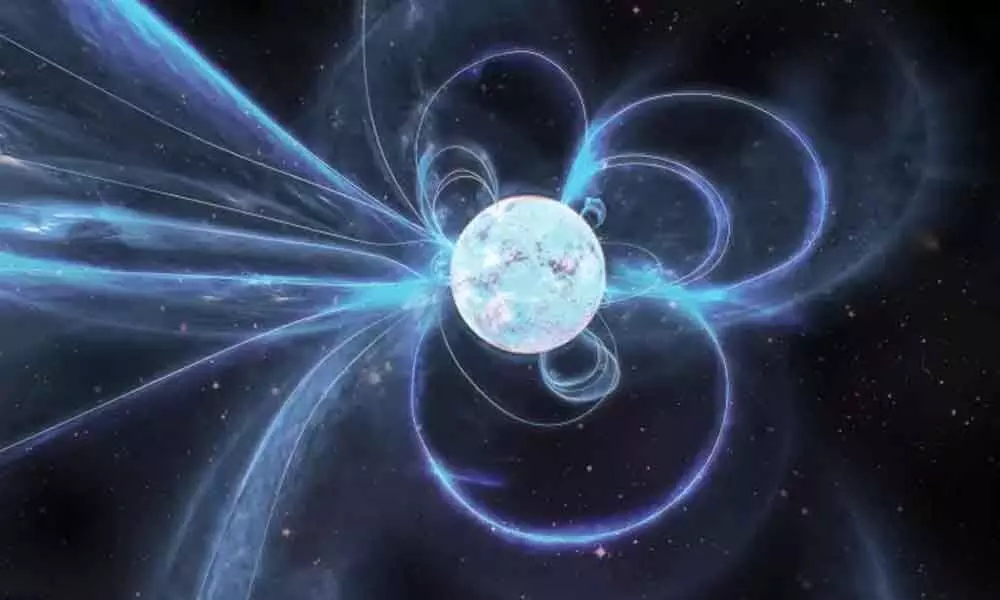Live
- Gaza has become 'graveyard' for children: UNRWA chief
- Sheesh Mahal issue is very serious, says Kailash Gahlot who led BJP protest against Kejriwal
- Africa CDC chief underlines local manufacturing of drugs
- 1-metre sea level rise by 2100 to affect over 14 mn people living in coastal areas: Study
- Jordan sends helicopter fleet for aid delivery to Gaza
- Strengthened by steel sector, India emerging as 5th largest global economic power: Kumaraswamy
- Sensex ends 422 points down, Nifty below 23,350 over weak global sentiment
- Cancel flights delayed beyond 3 hours, govt tells airlines
- Canada's Employment Minister resigns
- BGT 2024-25: Shastri picks Jadeja as key spinner for India in first Test
Just In
Understanding Magnetar, the new discovery


Representational Image
Scientists have found the first clues to understand violent short duration flares from a compact star of rare category called magnetar located thirteen million light years away.
Scientists have found the first clues to understand violent short duration flares from a compact star of rare category called magnetar located thirteen million light years away. These compact stars with the most intense magnetic field known, of which only thirty have been spotted so far in our galaxy, suffer violent eruptions that are still little known due to their unexpected nature and their short duration.
Scientists have long been intrigued by such short and intense bursts - transient X-ray pulses of energies several times that of the Sun and length ranging from a fraction of a few millisecond to a few microseconds. When massive stars like supergiant stars with a total mass of between 10 and 25 solar masses collapse they might form neutron stars.
Among neutron stars, stands out a small group with the most intense magnetic field known: magnetars. A scientific group headed by Prof Alberto J Castro-Tirado from the Andalusian Institute of Astrophysics (IAA-CSIC) studied an eruption in detail: managing to measure different oscillations, or pulses during the instants of highest energy, which are a crucial component in understanding giant magnetar flares.
Dr Shashi Bhushan Pandey from Aryabhatta Research Institute of Observational Sciences (ARIES), an Institute of the Department of Science and Technology worked closely with Prof Alberto Castro Tirado and other group members in this research which has been published in the journal Nature. This is the first extragalactic magnetar studied in detail. Now, we finally get to magnetars.
One may guess from the name that they're especially magnetic: up to 1 quadrillion gauss (a unit of magnetic induction). That's 1,000 trillion times stronger than the magnetic field you're sitting in right now. That puts magnetars in the No 1 spot, reigning champions in the universal Strongest Magnetic Field competition.
The numbers are there, but it's hard to wrap our brains around them. Why should we study these? Well, we are exploring space and in the process, we are reaching new frontiers. It is always better to know who is waiting for us in the unknown dark world out there. Isn't it so? These magnetar fields are strong enough to wreak havoc on their local environments.
We all know how atoms are made of a positively charged nucleus surrounded by negatively charged electrons? Those charges respond to magnetic fields. Not very much under normal conditions. Any unlucky atoms stretch into pencil-thin rods near these magnetars. It doesn't stop there. With the atoms all screwed up, normal molecular chemistry is just a no-go.
And the magnetic fields can drive enormous bursts of high-intensity radiation. Get too close to one (say, within 1,000 kilometers, or about 600 miles), and the magnetic fields are strong enough to upset not just one's bioelectricity — rendering one's nerve impulses hilariously useless — but the very molecular structure. In a magnetar's field, one just kind of … dissolves.
Continuous monitoring of magnetars in nearby galaxies will help to understand this phenomenon, and will also pave the way to learn more about fast radio bursts, today one of the most enigmatic phenomena in astronomy. We got to know about all these and much more...if only to understand our locus standi in the ever expanding universe!

© 2024 Hyderabad Media House Limited/The Hans India. All rights reserved. Powered by hocalwire.com






